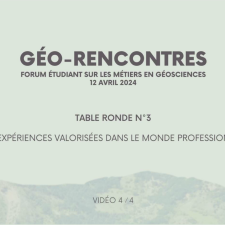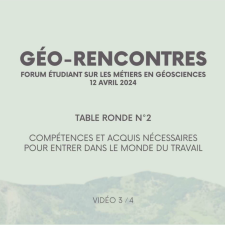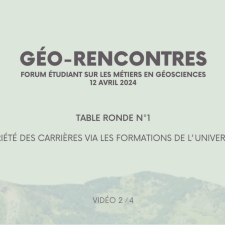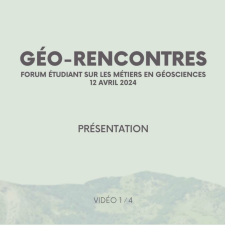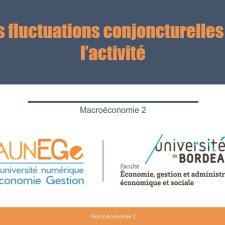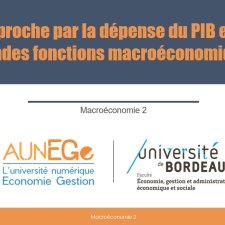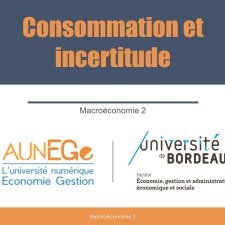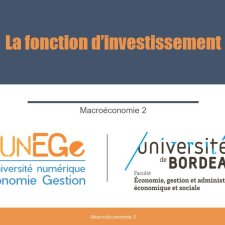Chapitres
- The Start and the End of Our Interglacial19'22"
- Discussion05'36"
Notice
The Start and the End of Our Interglacial
- document 1 document 2 document 3
- niveau 1 niveau 2 niveau 3
Descriptif
The previous interglacial (Marine isotope stage 5e, peaking at 125 kyr BP) is usually assumed to be a good analogue for our present-day climate. Moreover, as our present interglacial, the Holocene, is already almost 12 kyr long, paleoclimatologists were inclined to predict a quite close entrance into the next ice age. Simulations using the 2.5-D climate model of Louvain-la- Neuve show however that our interglacial will most probably last much longer than any previous one, even without human intervention (Berger and Loutre, 2002). It was suggested that this is related to the shape of the Earth’s orbit around the Sun which will be almost circular over the next tens of thousands of years. A circular orbit means indeed that the latitudinal and seasonal distributions of the energy received from the Sun will not vary anymore, a situation which will give more weight to the other forcings, in particular to the forcing by the greenhouse gases.
As the eccentricity variation is primarily related to the 400-kyr cycle, the best and closer analogue for such a forcing is definitively Marine isotopic Stage 11 (MIS-11) some 400 kyr ago and not MIS-5e. Simulations of this MIS-11 interglacial under greenhouse gas and astronomical forcings led indeed also to an anomalous length, a prediction which was later confirmed by the EPICA ice-core record.
Such a relationship between CO2 and climate is at the basis of the claim by Ruddiman (2003) that the impact of human activities on climate might have already started 10,000 years ago, preventing our climate to have already entered into glaciation. Sensitivity experiments with the LLN model tend to rule out Ruddiman’s hypothesis because glacial inception in this model would require CO2 concentration below 240 ppmv during the Holocene. However, honest estimates of model uncertainties incline us to leave the question open (Crucifix and Berger, 2006).
Our results show not only that the Holocene might last particularly long, but also that the sensitivity of our climate system to the greenhouse gas forcing might be exacerbated. It is therefore not surprising that, in our model at least, there is a threshold in the greenhouse gas concentration of about 700 ppmv beyond which the Greenland ice sheet melts in about 5000 years and does not recover before a few tens of thousands of years.
All these results confirm that the CO2 concentration in the atmosphere plays an important role in shaping the long-term climatic variations and that a detailed reconstruction of the interglacials from land, deep-sea and ice records is urgently needed.
Intervention / Responsable scientifique
Dans la même collection
-
Global Climate Change: Past and Future
MannMichael E.My presentation will begin with a review of the now-solid evidence for a human influence on the climate of recent decades. Such evidence includes instrumental measurements available for the past two
-
Modelling Forced and Internal Climate Variability During the Last Millennium
GoosseHughesAt hemispheric scale, the surface temperature is strongly influenced by the 28 variations of the natural (solar and volcanic) and anthropogenic (land-use, sulphate aerosols, greenhouse gas
-
A Roadmap to Assess the Economic Cost of Climate Change with an Application to Hurricanes in the Un…
HallegatteStéphaneThis talk presents a methodological roadmap to assess macro-economic damages from climate change. To do so, it explores a single manifestation of climate change in a single location: an increase in
-
Industrial and Environmental Policies: Reciprocal Impacts
ChauvinDominiqueTotal as a key player of the Oil and Gas industry is providing answers to 25 environmental challenges. In that respect, it has already developed environmental objectives and policies. Its
-
Post-2012 options to Reduce Greenhouse Gas Emissions
DuvalRomainThe presentation will focus on post-2012 options to reduce greenhouse gas (GHG) emissions, putting special emphasis on the need to abate world emissions. The presentation will focus on post-2012
-
The Intergenerational Equity: A Concept to Build for Sustainability, the Case of Global Warning
DjédjéOkoubi Franck DidierDefined as “the relation that each generation has with the last or future generations in the use... of the natural or cultural resources of planet”, Intergeneration equity (here I.E) imposes rules of
-
Round Table
JoussaumeSylvieChanzyAndréSomervilleRichardDuvalRomainThe European Science Foundation (ESF) and the French Foundation of the Maison des Sciences de l’Homme (FMSH) (within the Entre-Sciences programme) have agreed to jointly develop a new conference
-
Holocene Climatic Changes and Their Effect on Morphodynamics and Sedimentation in Campania
AmatoVincenzoHigh-resolution paleoclimatic studies (e.g. 18O, 13C, CH4, MS, ect) provide 38 detailed reconstructions of the Holocene climatic variability, but they don’t are unable to provide direct informations
-
Debate
JoussaumeSylviePlantonSergeGonzales RoucoJesus FelipeGoosseHughesReissellAnniBrasseurGuyThe European Science Foundation (ESF) and the French Foundation of the Maison des Sciences de l’Homme (FMSH) (within the Entre-Sciences programme) have agreed to jointly develop a new conference
-
Linking Adaptation and Mitigation for Climate Risk Reduction
ShogrenJason F.How people privately and collectively adapt to climate risk can affect the costs and benefits of public mitigation policy (e.g., Kyoto); an obvious point often neglected in actual policy making.
-
Social Impact of global Environmental Change on Farming Communities on the Ogoli River Bank in Otuk…
Anjeinu AbuGodwinOne of the manifestations of the global change in this study area is a marked reduction in the duration and amount of rainfall. This adversely affects the volume of the head waters that ultimately
-
How to Foster the Economic and Societal Technical Solutions?
CallonecGaëlThe presentation will focus on the interplay between economic scenarios (based on energy demand and CO2 emission reduction) with long run-public policies. The French case will be discussed in more
Avec les mêmes intervenants et intervenantes
-
Debate
BergerA.GuiotJoëlMannMichael E.DanisPierre-AlainAmatoVincenzoThe European Science Foundation (ESF) and the French Foundation of the Maison des Sciences de l’Homme (FMSH) (within the Entre-Sciences programme) have agreed to jointly develop a new conference
Sur le même thème
-
Géo-Rencontres 2024 / Les expériences valorisées dans le monde professionnel
LilloEmmaAraujoJulieHuartFlorianDubreuRomainBuquetDamienChazalLauraBorieMarianeForum sur les métiers en géosciences organisé par les étudiants du CMI Ingénierie Géologique et Civile, Université de Bordeaux, 12 avril 2024
-
Géo-Rencontres 2024 / Compétences et acquis nécessaires pour entrer dans le monde du travail
BrinonJulietteAmoleFili-FenuaPretouFrédéricCampetHugoLiébauxAlbinDe AlemeidaMarie-LouPoirierAymericDufrenoyAudreyForum sur les métiers en géosciences organisé par les étudiants du CMI Ingénierie Géologique et Civile, Université de Bordeaux, 12 avril 2024
-
Géo-Rencontres 2024 / Variété des carrières via les formations de l'université
InguimbertDianeLacazeRomaneLemaitreLaurieChazalLauraMontjeanPascalPoudevigneJacquesPortefaixFrédéricForum sur les métiers en géosciences organisé par les étudiants du CMI Ingénierie Géologique et Civile, Université de Bordeaux, 12 avril 2024
-
Géo-Rencontres 2024 / Présentation
LatasteJean-FrançoisLavieThéoForum sur les métiers en géosciences organisé par les étudiants du CMI Ingénierie Géologique et Civile, Université de Bordeaux, 12 avril 2024
-
Tokyo, plus grande « ville » au monde : aménager et gouverner la démesure
Languillon-AusselRaphaëlAvec ses quelques trente-cinq millions d’habitants, Tokyo est la « ville » la plus peuplée au monde, et l’une des métropoles les plus riches. Cette présentation vise à décrire, analyser et expliquer,
-
Les fluctuations conjoncturelles de l’activité
Maveyraud-TricoireSamuelLes fluctuations conjoncturelles de l’activité
-
Les fluctuations du revenu courant et le lissage de la consommation
Maveyraud-TricoireSamuelLes fluctuations du revenu courant et le lissage de la consommation
-
L'origine des fluctuations de la demande
Maveyraud-TricoireSamuelL'origine des fluctuations de la demande
-
L'approche par la dépense du PIB et les grandes fonctions macroéconomiques
Maveyraud-TricoireSamuelL'approche par la dépense du PIB et les grandes fonctions macroéconomiques
-
-
-



